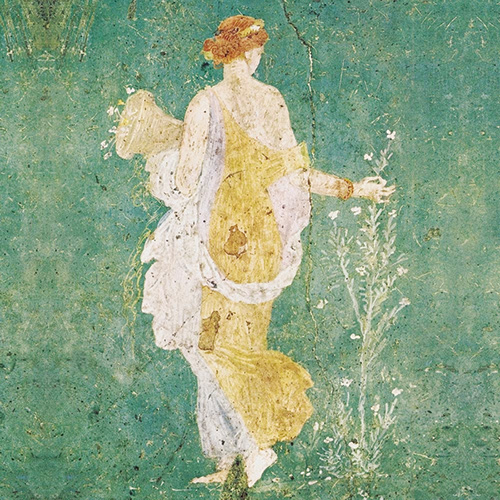
Fresco of Primavera (or Flora), ca. 1st cent., Stabiae
Our modern world echoes and sometimes replicates the creative vestiges of the past—and one key to understanding our surroundings is through an overview of ancient material culture. Focusing on the Mediterranean region, art historian Renee Gondek surveys the earliest traces of artistic production from the Paleolithic period through the late Bronze Age (roughly 1,500,000 B.C.E. through 1100 B.C.E.).
July 9 The Paleolithic and Neolithic Periods
Tens of thousands of years before the invention of writing, ancient peoples of the Mediterranean created some of the first sculptures and paintings, such as the Venus of Willendorf and cave paintings from Lascaux and Altamira. New agricultural practices and the development of permanent settlements during the Neolithic period allowed for the development of large-scale architecture and monumental sculpture, such as Stonehenge in England.
July 16 The Ancient Near East
Mesopotamia’s Fertile Crescent was a large oasis where human life and artistic endeavors flourished. Explore Sumerian, Akkadian, Neo-Sumerian, Babylonian, Assyrian, and Neo-Babylonian art, from the intricately carved Warka Vase to the famed Ishtar Gate.
July 23 Ancient Egypt
Journey down the Nile during the third and second millennia B.C.E. and discover the massive mortuary and ritual complexes of the pharaohs, including the Great Pyramids at Giza, the funerary temple of Hatshepsut, the Tomb of Tutankhamen, and the Great Temple of Ramses II at Abu Simbel. Iconic Egyptian sculptures and beautifully preserved frescoes and papyri are also examined.
July 30 The Aegean Bronze Age
Dig into the archaeological remains of the earliest Greeks—from the labyrinthian, well-planned palace of “King Minos” on Crete to the well-fortified citadel of Mycenae in the Argolid and from the bull leapers and snake goddesses of ancient Minoan deposits to the golden death masks and ceremonial daggers from well-furnished Mycenaean graves.
4 sessions
World Art History Certificate core course: Earn 1 credit*
General Information
*Enrolled participants in the World Art History Certificate Program receive 1 core course credit. Not yet enrolled? Learn about the program, its benefits, and how to register here.